Solar eclipse of March 29, 2006
| Solar eclipse of March 29, 2006 | |
|---|---|
|
Totality from Side, Turkey | |
 Map | |
| Type of eclipse | |
| Nature | Total |
| Gamma | 0.3843 |
| Magnitude | 1.0515 |
| Maximum eclipse | |
| Duration | 247 sec (4 m 7 s) |
| Coordinates | 23°12′N 16°42′E / 23.2°N 16.7°E |
| Max. width of band | 184 km (114 mi) |
| Times (UTC) | |
| (P1) Partial begin | 7:36:50 |
| (U1) Total begin | 8:34:20 |
| Greatest eclipse | 10:12:23 |
| (U4) Total end | 11:47:55 |
| (P4) Partial end | 12:45:35 |
| References | |
| Saros | 139 (29 of 71) |
| Catalog # (SE5000) | 9521 |
A total solar eclipse occurred on March 28-29, 2006. A solar eclipse occurs when the Moon passes between Earth and the Sun, thereby totally or partly obscuring the image of the Sun for a viewer on Earth. A total solar eclipse occurs when the Moon's apparent diameter is larger than the Sun's, blocking all direct sunlight, turning day into darkness. Totality occurs in a narrow path across Earth's surface, with the partial solar eclipse visible over a surrounding region thousands of kilometres wide. It was visible from a narrow corridor which traversed half the Earth. The magnitude, that is, the ratio between the apparent sizes of the Moon and that of the Sun, was 1.052, and it was part of Saros 139.
Visibility
.gif)
The path of totality of the Moon's shadow began at sunrise in Brazil and extended across the Atlantic to Africa, traveling across Ghana, Togo, Benin, Nigeria, Niger, Chad, Libya, and a small corner of northwest Egypt, from there across the Mediterranean Sea to Greece (Kastellórizo) and Turkey, then across the Black Sea via Georgia, Russia, and Kazakhstan to Western Mongolia, where it ended at sunset. A partial eclipse was seen from the much broader path of the Moon's penumbra, including the northern two-thirds of Africa, the whole of Europe, and Central Asia.
Observations
People gathered in large areas where solar eclipse is visible around the World to view the event. Manchester Astronomical Society, the Malaysian Space Agency, the Astronomical Society of the Pacific, as well as dozens of tour groups met at the Apollo temple and the theater in Side, Turkey. The San Francisco Exploratorium featured a live webcast from the site, where thousands took their seats in the ancient, Roman-style theater.[1]
Almost all actively visited areas in the path of totality had perfect weather. Many observers reported an unusually beautiful eclipse, with many or all effects visible, and a very nice corona despite proximity to solar minimum. The partial phase of the eclipse was also visible from the International Space Station, while the astronauts on board took spectacular pictures of the shadow on the Earth's surface. At first, it looked as though an orbit correction in the middle of March would bring the ISS in the path of totality, but this correction was postponed.
Gallery
 Sahara, Libya, 10:11 UTC
Sahara, Libya, 10:11 UTC Valencia, Spain, 10:16:05 UTC
Valencia, Spain, 10:16:05 UTC Smolyan, Bulgaria, 10:30 UTC
Smolyan, Bulgaria, 10:30 UTC Side, Turkey, 10:55 UTC
Side, Turkey, 10:55 UTC
 Berkhamsted, England, 11:01 UTC
Berkhamsted, England, 11:01 UTC Novosibirsk, Russia, 11:42 UTC
Novosibirsk, Russia, 11:42 UTC Krasnoyarsk, Russia, 12:21 UTC
Krasnoyarsk, Russia, 12:21 UTC Kalmykia, Russia, 12:22 UTC
Kalmykia, Russia, 12:22 UTC

Satellite failure
The satellite responsible for SKY Network Television, a New Zealand pay TV company, failed the day after this eclipse at around 1900 local time. While SKY didn't directly attribute the failure to the eclipse, they said in a media release that it took longer to resolve the issue because of it, but this claim was refuted by astronomers. The main reason for the failure was because of an aging and increasingly faulty satellite.[2]
Related eclipses
This solar eclipse was preceded by the penumbral lunar eclipse on March 14, 2006.
Solar eclipses 2004–2008
Each member in a semester series of solar eclipses repeats approximately every 177 days and 4 hours (a semester) at alternating nodes of the Moon's orbit.
| Ascending node | Descending node | |||
|---|---|---|---|---|
| Saros | Map | Saros | Map | |
| 119 | 2004 April 19 Partial (south) |
124 | 2004 October 14 Partial (north) | |
| 129 | 2005 April 8 Hybrid |
134 Annular from Spain |
2005 October 3 Annular | |
139 Total from Side, Turkey |
2006 March 29 Total |
144.jpg) Partial from São Paulo, Brazil |
2006 September 22 Annular | |
| 149 | 2007 March 19 Partial (north) |
154 | 2007 September 11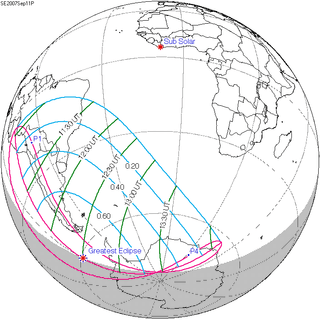 Partial (south) | |
Saros 139
It is a part of saros series 139, repeating every 18 years, 11 days, containing 71 events. The series started with partial solar eclipse on May 17, 1501. It contains hybrid eclipses on August 11, 1627 through December 9, 1825 and total eclipses from December 21, 1843 through March 26, 2601. The series ends at member 71 as a partial eclipse on July 3, 2763. Members in the same column are one exeligmos apart and thus occur in the same geographic area.
The solar eclipse of June 13, 2132 will be the longest total solar eclipse since July 11, 1991 at 6 minutes, 55 seconds.
The longest duration of totality will be produced by member 39 at 7 minutes, 29 seconds on July 16, 2186.[3] This is the longest solar eclipse computed between 4000BC and 6000AD.[4]
| Series members 24–39 occur between 1901 and 2100 | ||
|---|---|---|
| 24 | 25 | 26 |
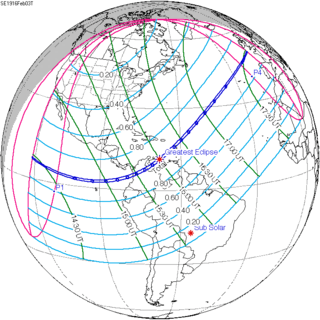 February 3, 1916 |
 February 14, 1934 |
 February 25, 1952 |
| 27 | 28 | 29 |
 March 7, 1970 |
 March 18, 1988 |
 March 29, 2006 |
| 30 | 31 | 32 |
 April 8, 2024 |
 April 20, 2042 |
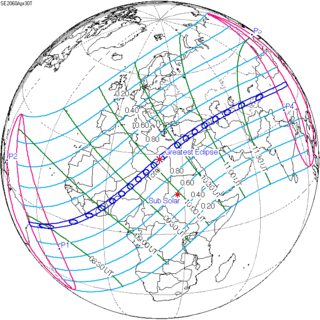 April 30, 2060 |
| 33 | 34 | 35 |
 May 11, 2078 |
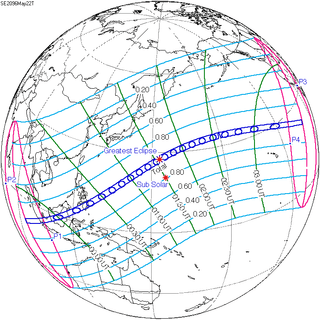 May 22, 2096 |
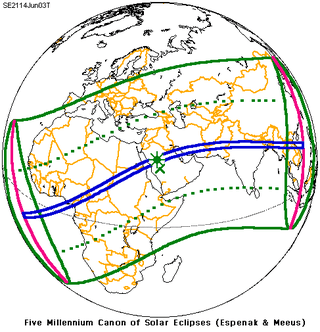 June 3, 2114 |
| 36 | 37 | 38 |
 June 13, 2132 |
 June 25, 2150 |
 July 5, 2168 |
| 39 | ||
 July 16, 2186 | ||
Metonic series
The metonic series repeats eclipses every 19 years (6939.69 days), lasting about 5 cycles. Eclipses occur in nearly the same calendar date. In addition the octon subseries repeats 1/5 of that or every 3.8 years (1387.94 days).
| 21 eclipse events, progressing from north to south between June 10, 1964 and August 21, 2036 | ||||
|---|---|---|---|---|
| June 10–11 | March 27–29 | January 15–16 | November 3 | August 21–22 |
| 117 | 119 | 121 | 123 | 125 |
 June 10, 1964 |
 March 28, 1968 |
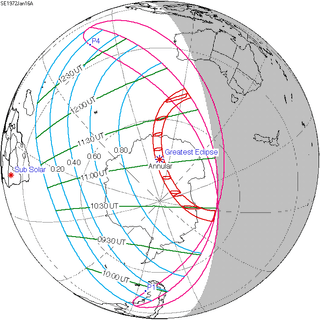 January 16, 1972 |
 November 3, 1975 |
 August 22, 1979 |
| 127 | 129 | 131 | 133 | 135 |
 June 11, 1983 |
 March 29, 1987 |
 January 15, 1991 |
 November 3, 1994 |
 August 22, 1998 |
| 137 | 139 | 141 | 143 | 145 |
 June 10, 2002 |
 March 29, 2006 |
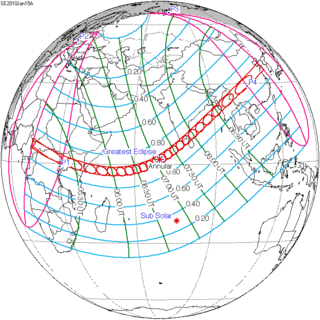 January 15, 2010 |
 November 3, 2013 |
 August 21, 2017 |
| 147 | 149 | 151 | 153 | 155 |
 June 10, 2021 |
 March 29, 2025 |
 January 14, 2029 |
 November 3, 2032 |
 August 21, 2036 |
Notes
- ↑ Total Solar Eclipse: Live from Turkey in 2006
- ↑ Press release by Sky TV. Solar eclipse interferes with satellite restoration Friday, 31 March 2006.
- ↑ Saros Series Catalog of Solar Eclipses NASA Eclipse Web Site
- ↑ Ten Millennium Catalog of Long Solar Eclipses, -3999 to +6000 (4000 BCE to 6000 CE) Fred Espinak
References
- Fred Espenak and Jay Anderson. "Total Solar Eclipse of 2006 March 29". NASA Technical publication (NASA/TP-2004-212762), November 2004.
- NASA - Total Solar Eclipse of 2006 March 29
- Earth visibility chart and eclipse statistics Eclipse Predictions by Fred Espenak, NASA/GSFC
- solar-eclipse-2006.info Information about the March 29th Solar Eclipse.
- Interactive 2006 March 29 Total Solar Eclipse map with local circumstances
- Eclipse.za.net, Umbral Paths of March 29 Eclipse in Africa
Photos:
- Prof. Druckmüller's eclipse photography site. Turkey, Cappadocia
- Prof. Druckmüller's eclipse photography site. Egypt
- Prof. Druckmüller's eclipse photography site. Libya
- Total eclipse photographs from Turkey
- Another set of total eclipse photographs from Turkey
- Photo gallery from Turkey
- Phases of solar eclipse view from Antalya
- NASA videos and photos from Libya and Turkey
- Pictures taken from Smolyan, Bulgaria
- NASA video of eclipse
- Solar eclipse images and videos from Libya by traveling NASA employees and scientists
- Images by Crayford Manor House Astronomical Society from Libya and Turkey
- Spaceweather.com Eclipse gallery
- Antwrp.gsfc.nasa.gov APOD, 3/30/2006, When Diamonds Aren't Forever, totality from Greek island of Kastelorizo in the eastern Aegean
- Antwrp.gsfc.nasa.gov APOD, 4/4/2006, A Total Solar Eclipse over Turkey, totality from Adrasan, Kumluca, Antalya Province, Turkey
- Antwrp.gsfc.nasa.gov APOD, 4/7/2006, totality from Side, Turkey, a larger version of the same picture chosen as APOD again on 7/26/2009, The Big Corona, Koenvangorp.be
- Antwrp.gsfc.nasa.gov APOD, 4/8/2006, Vanishing Umbra, from Mount Hasan southeast of İncesu, Aksaray, Turkey
- The 2006 Eclipse in Turkey
- Russian scientist observed eclipse
- University of Athens - Solar Eclipse 29/3/2006, Solar Party
- Solar Total Eclipse of 2006 March 29
- Tubitak.gov.tr, 29 March 2006 Total Solar Eclipse, Scientific and Technological Research Council of Turkey (TÜBİTAK)
- Solar Eclipse over Kemer, Turkey 060329
| Wikimedia Commons has media related to Solar eclipse of 2006 March 29. |
